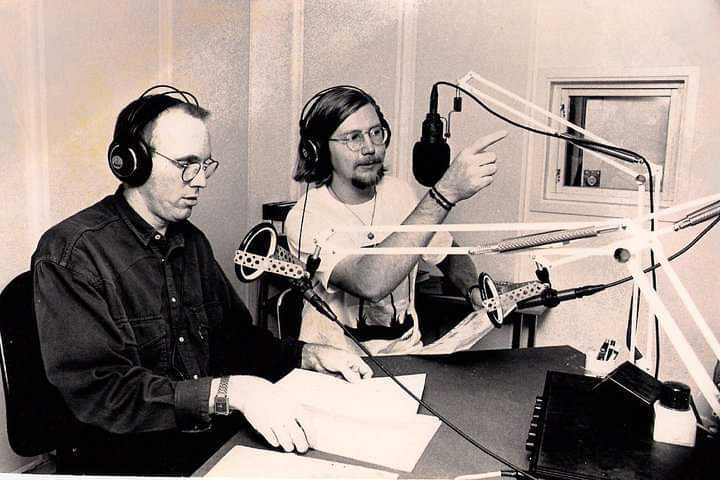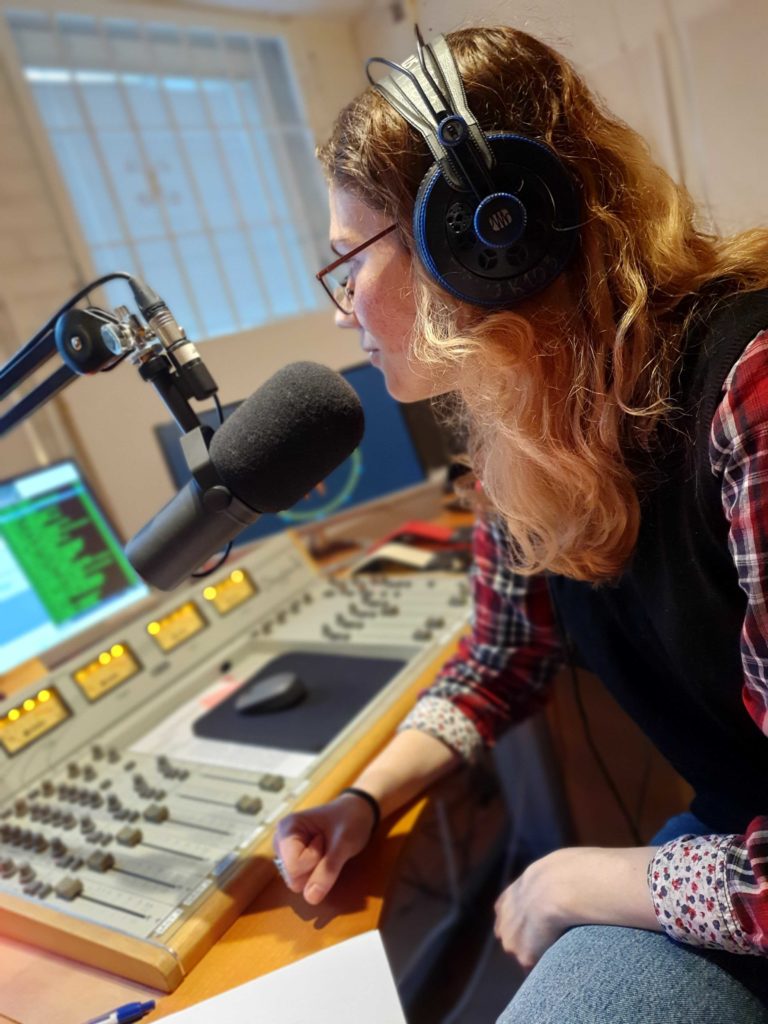Authors: Eden Maclachlan & Eva Gustavfsson
At the turn of 2024, Piteå FM, Sweden’s most northern student radio, located in the small student town of Piteå in Norrbotten, closed up shop after 20 years of activity. It was yet another independent Swedish community radio shutting down, marking out a trend that has become worryingly recurrent over the last few years–FM stations are closing and the listeners are fewer and fewer. This was highlighted in the latest edition of The Swedish Media Barometer, an annual survey focusing on how the Swedish population uses media on traditional and digital platforms on an average day. In 2022, a total of 7% of the population listened to community radio on a daily basis, representing a drop of 1% compared with the previous year, while over the same period, the scope of radio listeners increased by 2%.

Roden Bergenstein and Claes Hansson in the studio of K103 Gothenburg Student Radio in the early 1990s
In fact, tougher competition in the audio field, new technologies, and consumption habits, also coupled with a lack of interest from newer generations, are some of the challenges that those independent media are facing and the reason why the community radio frequencies are starting to get more empty nowadays.
A Strong Start Overshadowed by the Arrival of Commercial Radio
In Sweden, community and student radios were launched in 1979. With only Swedish Public Service Radio to compete against, they quickly gained in popularity. Many had their local community radio as their medium of choice, listening daily to keep up with the latest news and musical releases. According to Roden Bergenstein, station manager of Göteborgs Närradioförening and involved with student radio since 1991, the first big change came in 1993 with the arrival of commercial radio stations. This is the year radio was released free in Sweden and a number of new frequencies were auctioned off. This meant that advertising was now a possibility.
Prior to 1993, commercial radio broadcasted music shows via community radio, while waiting on the possibility to buy their own frequencies, which was a mutual benefit to attract listeners. However, when commercial radios moved to their own frequencies in 1993, they took with them a sensible amount of the community radio audience, leaving the latter’s frequencies and radio schedule fairly empty. Which in return, does not attract nor hold audiences.
New Technologies and New Consumer Habits
With the new century came new technologies and a change in consumer’s habits which proved to be an even tougher challenge. In this fast changing world, the way we produce and consume audio has drastically changed over the last few years. Community and student radio are members-driven organisations and have always relied heavily on their active participation in order to run the day to day work, but most importantly to broadcast.
Cheaper and more accessible recording equipment coupled with the rise of on demand, podcasting, streaming platforms, and social media have changed how one broadcasts radio and consumes audio content. This has made it more accessible for individuals to independently start their own podcast or radio shows without being a member of a community radio.
Audiences have also changed their habits regarding radio and audio consumption. This gets perfectly highlighted in the latest edition of The Swedish Media Barometer. According to the survey, 64% of the age group 65-85 listens to radio through a traditional radio device on a regular day. This figure drops to 12% for the age group 15-24. However, when it comes to listening to podcasts on a daily basis, the highest range is between 15 to 24 and 25 to 44 years old, whereas the lowest is in the age group 65 to 85. “The newer generations are not interested in the traditional form of radio broadcasting and never replaced the older ones” says Roden Bergenstein. “Those who were involved in the beginning have now either stopped or passed away. We also used to have huge groups broadcasting in Spanish, Bosnian or Farsi. They had a lot of time to broadcast radio, but now they all got jobs and are not available during the day anymore. The generation that would take over found other forums for music, e.g. Spotify, mp3 players. Opinions and stories are instead made on the media that young people are used to, the computer or telephone. Therefore, the focus is podcast, blog, YouTube, social media, etc. They don't need nor see the purpose of radio.” This in return, has resulted in a broadcasters and audience shift that might explain the decline of FM community and student radios. Many FM stations have added a stream version of what can be heard on the frequency online, to make the broadcasting more accessible. However since the content produced on the FM frequency is in decline, the stream is mainly filled with pause music. This neither inspires more producers nor listeners.

Elvira Hodzic in the studio of K103 Gothenburg Student Radio 2024 – © Eva Gustavfsson
The drop in the amount of broadcasted hours has made it more expensive for the remaining stations, since you share the fees for the frequency. For independent media, money and funding are often a source of issues and worries. The Swedish student and community radios are no stranger to that matter. Finding regular and sustainable ways of funding has been and still is a challenge nowadays. In fact, there are very few forums and grants where one can get funding money, and most, who are project oriented funding, do not fund the regular day to day activities of the station. Närradions riksorganisation (NRO), the umbrella organisation regrouping community radios in Sweden, is hoping to get regular funding from the Swedish department of culture to keep them afloat. However, it has yet to materialise, leaving many stations in precarious uncertainties and concerned about their funding situation.
Trying to Adapt at a Slow Pace
The development of student radio looks slightly different from the one of community radio. What started off as organisations closely connected to student unions has in many cities transformed into independent student and youth run radio stations. When funding has been hard to find the student unions have cut back on resource consuming activities like running a radio station. However the interest from the active students has in many occasions saved and taken over the lead of the stations and themselves taken on the task of finding funding. This is a lot of work for organisations mainly relying on volunteer workers. Most stations have no staff and all activities are done in the students' free time. Funding is hard to find and time consuming to apply to. But students are resourceful, adaptable, and tenacious. This has changed the stations from only being FM stations to web streaming and now sometimes only focusing on pod production. When it's hard to balance your budget, and your target audience moves on to on demand listening, you have to follow. Web streamed radio and pod production require less equipment, tech skills, space, and funding. This change is however also a threat to student radio stations, because this also means that anyone can start a podcast and the need to be part of a station to do so is shrinking. In a world where individualism rules the community is struggling. The transformation of student radio is another blow to the community radio which here loses another collaborator and with it the participation of the younger generations.
What Does the Future Hold?
Despite all those challenges, community and student radio still have an important role to play in the Swedish media landscape. From a democratic perspective, it is crucial to have independent community radio enabling various communities to have a voice and an arena to express their opinions, that can be left out of other media, while in the meantime be an educational medium where members learn how to produce and broadcast radio, directly training the next generation of radio journalists. Community and student radio make the Swedish media landscape broader and society more inclusive. Although the future of independent Swedish community and student radios is looking rather bleak, there is still hope that the tide will turn. But the answers might come from outside of Sweden. In fact they lie within Europe. “NRO is looking at other European countries where they have managed to recruit and engage newer generations. We are trying to get some inspiration from what they have done and implement it in Sweden” says Roden Bergenstein.
Published on June 11th, 2024
About the authors:
Eden Maclachlan is a project manager for Studentradion i Sverige and an editor for K103 Gothenburg Student Radio.
Eva Gustavfsson is the station manager at K103 Gothenburg Student Radio. She has been producing radio and media content since the teens.